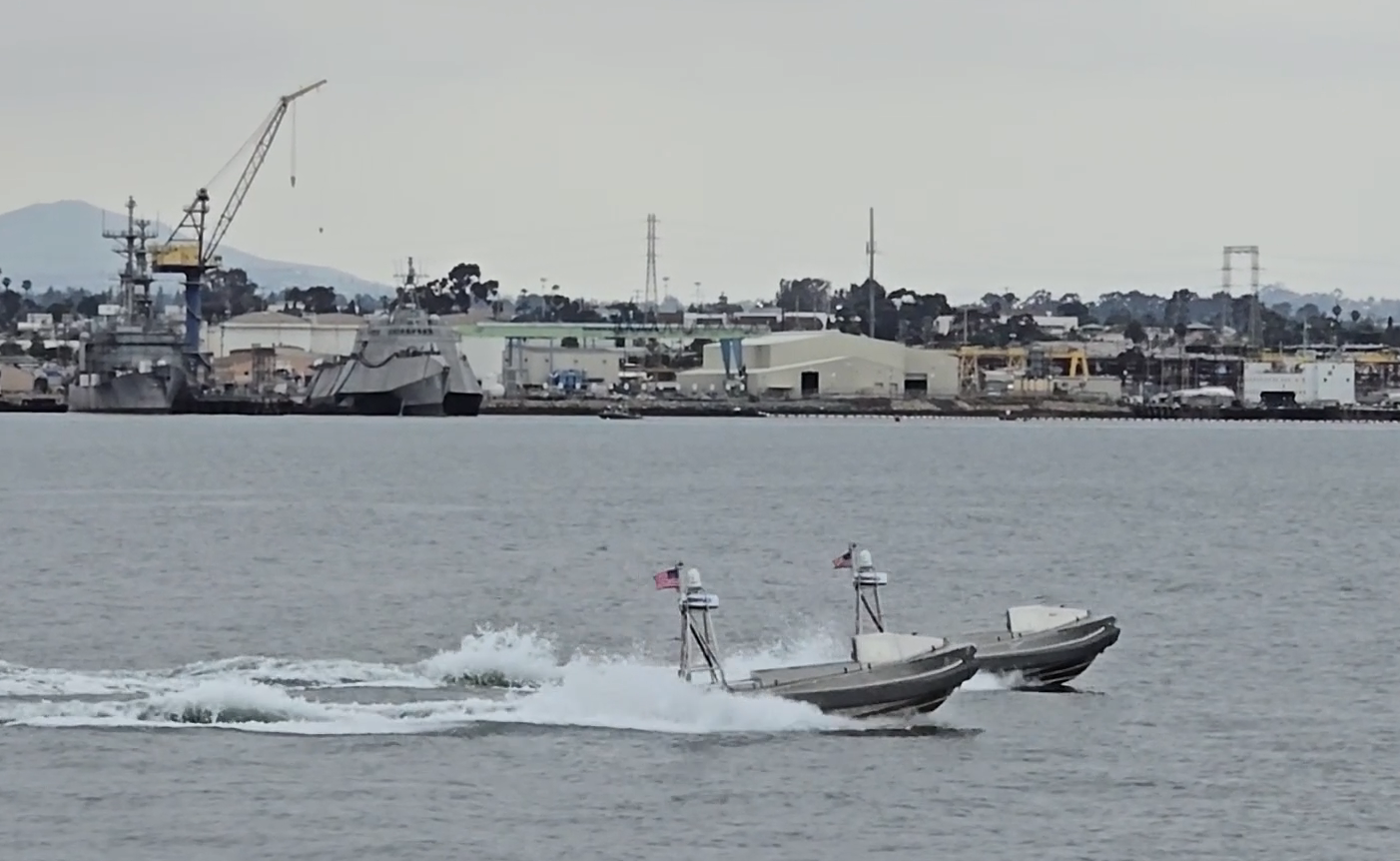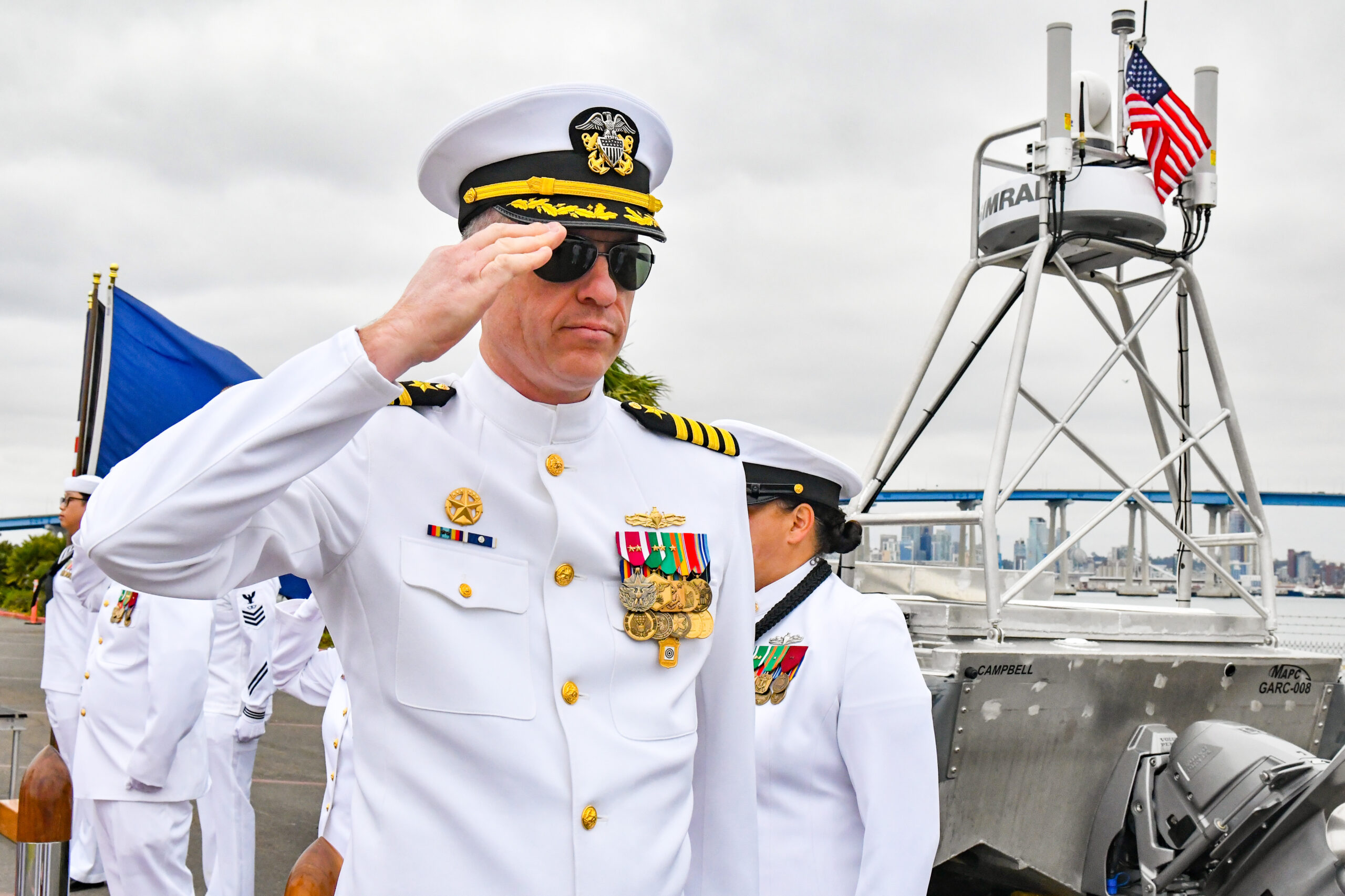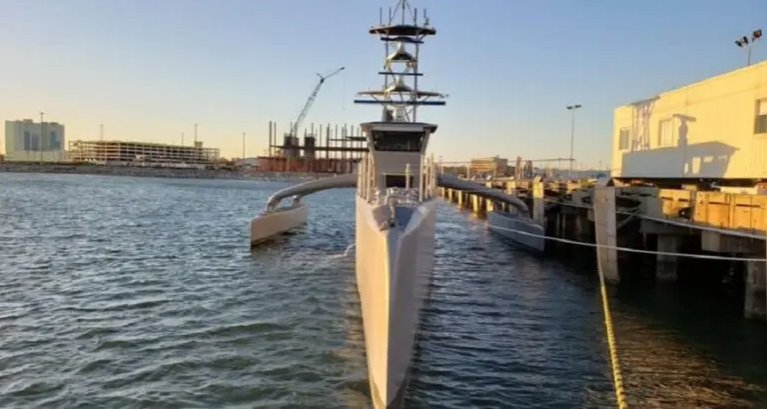
CORONADO, Calif. – The Navy on Friday took another step toward creating a surface fleet seamlessly integrated with uncrewed vessels by formally establishing its second unmanned surface drone unit.
The new unit, the “Hell Hounds” of Unmanned Surface Vessel Squadron 3, has received the first four Global Autonomous Reconnaissance Craft of what’s expected to be “hundreds” of unmanned surface vessels that will deploy and operate with the surface force’s guided-missile destroyers, Navy officials said.
The squadron’s more immediate mission, however, is to continue testing and operating GARCs to determine concepts, plans and uses for future USVs that will integrate with fleet ships and requirements for its growing community of crews that will operate and maintain the small USVs.
“[There] is no guidance or reference we can turn to. This course has not yet been charted by our surface force,” Navy Capt. Shea Thompson, commander of Surface Development Group 1 in San Diego, said during the ceremony at Naval Amphibious Base Coronado, Calif. “We collectively are writing the instruction manuals, qualification standards, concepts of operations and developing the tactics, techniques and procedures for employment of these platforms as we strive to accelerate delivery of USV capability to the fleet.”
The Navy wants to operate low-cost, high-endurance, autonomous USVs equipped with sensors and weapon systems in tandem with its surface combatants. The USVs would be programmed with missions and have no need for direct, physical human control. The GARC is a 16-foot aluminum prototype USV built by Maritime Applied Physics Corp., a Baltimore, Md.-based naval technology firm.
Well before Friday’s establishment ceremony, the first groups of USVRON-3 plankholders had put their small USVs through initial paces with fleet units, officials said. In March, just two weeks after their initial training and days after receiving the vessels, squadron crews were operating the first GARCs with a carrier strike group off California’s San Clemente Island in the eastern Pacific during U.S. Pacific Fleet’s Integrated Battle Problem 24.1.
They learned how to launch, operate and recover the USVs from shore and ships at sea, and “they developed vignettes to explore the effectiveness of the platform, the autonomy and the payloads,” Vice Adm. Brendan McLane, the Naval Surface Force commander, told the audience. “It was a leap forward in capability validation and development.”
GARCs and other drones “will be part of a vast cadre of unmanned systems with multiple combat and support functions,” McLane said. The Navy must operate them at sea “with the same steady routine at which we launch RHIBs or helicopters.”
While the USVs operate autonomously, the on-scene commander retains the “freedom to act within the commander’s intent,” he said, which then prompts some questions the Navy must sort: How does the service program that into its USVs? Where is the balance between machine automation and operator in the loop?
In 2019 the Navy’s surface fleet began focusing on USV innovation and experimentation and since has experimented, operated and deployed a handful of medium and large USVs, said Thompson, who oversees that work as the SURFDEVGRU-1 commodore. The recent western Pacific deployment of four USVs from Unmanned Surface Vessel Squadron 1, based at Port Hueneme, Calif., validated the Navy’s “Phantom Legion” concept of unmanned teaming for medium and large USVs, which have a different mission set than smaller drones, Thompson said. Medium USVs are sensors, supporting surface action or carrier strike groups operating over the horizon, he noted, while large USVs can operate as adjunct missile magazines for long-range maritime strike platforms.
A small USV “can be considered its own weapons system … depending on the payloads that it has,” Thompson said, but “it could complement the work” of the larger drones. Small USVs will be developed with five missions in mind, he added: maritime security; antiair warfare; surface warfare; antisubmarine warfare and intelligence, surveillance and reconnaissance.
Still, small USVs present a challenge, said Thompson. “It would be really hard to think outside the box, because the box doesn’t exist yet,” he said.
In parallel, the Department of Defense has earmarked $1B to develop the Replicator initiative that will use a combination of USVs and loitering munitions to create the emerging “hellscape” concept designed to counter an amphibious invasion of Taiwan.
Work Ahead for Squadron

USVRON-3 “will be a cornerstone in building the foundational knowledge required to operate and maintain USVs and will spearhead the development of tactics, techniques and procedures for all USVs,” McLane said. That includes leading all efforts to develop command and control, intelligence, surveillance and reconnaissance, maneuver and movement, protection and sustainment.
The Navy recently implemented the robotics systems technician rating, he said. The new rating will reflect the multimission and varied skills that squadron sailors eventually will need to operate and maintain USVs and autonomous systems, including computer and navigation autonomy, data systems, AI and machine learning. Surface warfare lieutenants will command small detachments of USV crews, Thompson said.
USVRON-3 began with 24 members but will grow to about 400 when fully staffed, officials said. They have been working with Naval Special Warfare Group 1 on USV employment and with Marine Corps organizations to help sort small USVs’ expeditionary roles.
“Unmanned and autonomous technologies are the key to growing distributed maritime operations,” said Capt. Derek Rader, the squadron commander. The human operators and technicians “are the center of gravity of everything that we do.”
The squadron first worked with the GARCs in operations in San Diego Bay before heading into the ocean and San Clemente Island, Rader said after the ceremony. “We are quite literally building the capability, the doctrine, and the way that we employ this with the contractor and government team.” He expects the squadron will operate the vessels farther west later in the year.
The squadron will continue receiving more GARCs, which run about $750,000 apiece, and changes to the platforms are being incorporated starting with hull 10, he said. “We plan to have these in possession in the 100s,” he added, declining to say how many USVRON-3 may get at full operational capability. “This is the first of a family of platforms that we will have” in the squadron.
Electronics Technician 2nd Class Kaleb Cox said the squadron works side-by-side with civilian contractors, including software developers. “They want us to break it, they want us to find flaws,” Cox said, “and we provide that feedback directly to them.”
He spent a year with USVRON-1 after serving as a navigation radar technician with guided-missile destroyers USS Benford (DDG-65) and USS Gridley (DDG-101). At USVRON-3, he used the GARC’s handheld controls while on a chase craft during operations off San Clemente Island. “It’s similar, but it’s definitely not the same,” he said, it to video game consoles.
“It’s really impressive that [I], as a second-class, [have] as much say as I do in the development of how we use this,” Cox added.
Innovation at the Forefront

McLane noted USVs follow continuing technological advances, from torpedoes to aerial drones, that have become essential assets that have transformed naval warfare.
“In the era of great power competition, USVs have a significant role to play and are now on an accelerated development path,” McLane said. “Like their air and unmanned ground counterparts, these unmanned maritime systems are valued because they reduce the risk to human life in high-threat areas, and because they deliver persistent surveillance over areas of interest and because they give warfighters an inherent advantage of unmanned technologies.”
He noted the Navy’s push for experimentation and innovation to counter growing threats, including ongoing experimentation with directed-energy weapons that “will likely be the best option to defeat them.”
“But the development timeline has taken too long,” he said. “Modern warfare requires faster innovation and adaptation. Our Navy needs to bring ideas to prototype, to experimentation, and to build solutions faster than ever,” like the GARC.
“With USVs and [artificial intelligence], we will need to continue to use that spirit of innovation as it is more important now than ever before,” he added.
The growing global proliferation and use of unmanned air systems and surface drones provides both threats and solutions, and even lessons learned. Ukraine’s modest navy has sunk or damaged 16 Russian ships “and [has] been able to deny the Russian Navy the use of the northwestern Black Sea,” McLane said, and forced the Russian fleet from their base in Sevastopol, a port city in occupied Crimea. “Ukraine has accomplished sea denial in the Black Sea through the employment of both UAS and USVs.”
Last year, Ukraine forces launched “at least 184 drone attacks” on Russian targets in the Crimean peninsula, “averaging one every other day,” he said. “It is of paramount importance that we continue this innovation now and into the future.”
Navy surface combatants operating in the Red Sea and with naval and contractor support “are innovating together to beat the threat,” McLane said. But new threats and challenges require the service to continue to foster innovation and new ideas, he said, “and work hard to bring these ideas to fruition.”
“It will be our sailors making it happen,” the commodore said, noting the small USVs will be the newest addition to “our system of systems.”
Small surface drones potentially can provide “extremely-capable optical, acoustic and even weapons packages. Small USVs must be considered in the operational commander’s planning and decision processes for maritime security, as well as across a broad spectrum of military operations,” said McLane. “The integration of small USVs into fleet operations and exercise[s] will increase our planning options and enhance our warfighting capabilities at a reduced risk to forces and at a reduced cost.”





